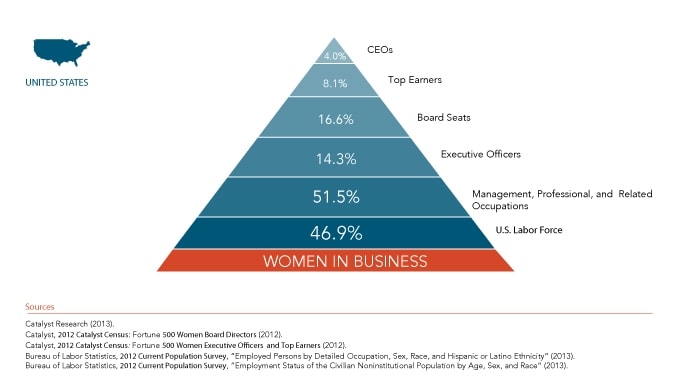The dearth of women in leadership positions is certainly not unrecognized. In fact, it is a heavily researched area, both in academic and applied settings. Recently, the topic has been brought back to the forefront with the release of Sheryl Sandberg’s book, Lean In: Women, Work, and the Will to Lead.
In her book, Sandberg discusses barriers to women’s ascent up the organizational ladder. In particular, she notes that whereas women occupy a significant portion of the workforce as a whole, they are still terribly underrepresented in upper level leadership positions. This phenomenon is illustrated in the following graphic which depicts a decreasing percentage of women in sequentially higher level positions.
These findings are quite remarkable, and frankly a bit disconcerting, considering the fact that women have been steadily challenging conventional stereotypes in the workforce.. While we may intuitively believe that organizations should be gender blind, so to speak, it is clear that gender issues in the workplace are still alive and well.
In light of these findings, Sandberg sends a strong message that women should continue working their way to the C-suite by learning to “lean in,” sit at the table where decisions are made, and perhaps most importantly, make their voices heard. The question remains: how do you do that successfully?
Why are women represented nearly equally in the U.S. labor force yet almost nonexistent as CEOs and Top Earners?
Decades of social science research suggest that this persistent occupational gender gap is driven in part by our traditional beliefs about how women and men are and how they should be. Because men are more typically viewed as assertive, dominant, and leader-like (i.e., masculine), they are perceived as “belonging” in leadership roles which require these traits. Women, on the other hand, are stereotypically perceived as lacking the masculine traits necessary to be successful in leadership roles. Rather, the expectation that women are and should be caring, kind, and communal conflicts with our prototype of what makes an effective leader.
There is ample evidence suggesting that in lower-level positions, stereotypical gender role beliefs create a perception that women are warmer (i.e., likeable) than their male counterparts. However, as women advance in an organization and display undeniable high performance and success, they gain perceived competence but may lose perceived warmth. In other words, women are faced with a Catch-22 in which they are perceived as incompetent and warm or competent and cold. Because both competence and likeability are predictive of promotion potential, this contributes in the underrepresentation of women in leadership positions.
Further, when women step into leadership roles in “male-typed” organizations (i.e., those historically dominated by men), this effect is exacerbated as women are perceived as strongly violating stereotypic expectations.
Before we write this situation off as hopeless, let’s consider our recent findings from a high potential program that included a 360 degree feedback workshop for 80 emerging executives. The workshop contained a roughly equal number of women and men who had already demonstrated strong leadership within their organization. Surprising was our finding that the women were perceived as being more effective than their male counterparts at controlling their environment, providing straightforward feedback, adopting an assertive management focus, leading with dominance, and setting high production standards. Broadly speaking, we found that women in this group had adopted a more traditional leadership style (i.e., assertive and dominant) whereas the men had more flexibility in the way they portrayed themselves. And guess what? Despite women’s display of counter-stereotypical traits, they were still liked.
Of course, as messengers of these results, we asked ourselves why this organization is different. Why are women displaying a leadership style more aligned with stereotypical traits whereas men’s style is characterized by a greater variety? Moreover, why are women in this particular organization able to be both successful and liked (a highly sought after, yet often elusive, combination)? Of course, these questions tap into a highly complex topic as gender issues are rooted in politics, economics, and social values (among others)—thus, we cannot provide any clear cut answer. However, we can certainly speculate what it is about this organization that creates such a unique situation.
These findings may be explained, in part, by looking at organizational culture and its effect on emerging leaders. This organizational culture may be such that women are encouraged to step into leadership roles and enact behavior that is consistent with what it takes to be successful. In other words, the organization may be sending a message that it values gender diversity and equal opportunity and as a result, women are modeling their behavior after what they deem as necessary for success (i.e., stereotypical traits enacted historically by leaders).
So what is the underlying message here?
First, as evidenced by our recent (and quite uplifting) findings, women can be viewed as both successful and likeable leaders. However, for this to occur, women may feel the need to conform to a stereotype in order to move up the managerial pipeline and break through the “glass ceiling.”
From Vantage’s point of view, we look forward to the day when both women and men feel comfortable adopting a leadership style that is consistent with whom they are rather than what they believe they should be.
Thus, we propose that the definition of successful leadership be broadened to allow all individuals to develop their own leadership style without feeling the need to conform to culturally constructed traits considered necessary to succeed. The reality is that leadership styles need to be tailored to the organization’s culture to be most effective.
And of course, we’d love to see the “glass ceiling” shatter in the process.

